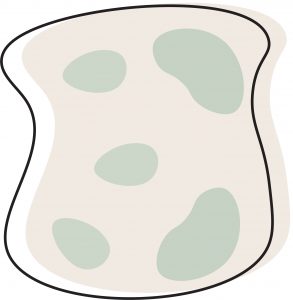 Moulds are fungi that grow in units called mycelium and reproduce through the formation of spores. Moulds are ubiquitous in the biosphere, and mould spores are a common component of household and workplace dust. Mould need food and water sources in order to thrive. This food source is often in the form of a carbohydrate material, such as wood or cellulose. Moulds need certain conditions of humidity and temperature to develop depending on the species. When conditions do not enable growth, moulds may remain alive in a dormant state, within a large range of temperatures before they die. Mould spores may remain airborne indefinitely, may cling to clothing or fur, or may be able to survive extremes of temperature and pressure. Although moulds grow on dead organic matter everywhere in nature, their presence is only visible to the unaided eye when mould colonies grow. However, moulds produce a musty odour that allows identifying their presence.
Moulds are fungi that grow in units called mycelium and reproduce through the formation of spores. Moulds are ubiquitous in the biosphere, and mould spores are a common component of household and workplace dust. Mould need food and water sources in order to thrive. This food source is often in the form of a carbohydrate material, such as wood or cellulose. Moulds need certain conditions of humidity and temperature to develop depending on the species. When conditions do not enable growth, moulds may remain alive in a dormant state, within a large range of temperatures before they die. Mould spores may remain airborne indefinitely, may cling to clothing or fur, or may be able to survive extremes of temperature and pressure. Although moulds grow on dead organic matter everywhere in nature, their presence is only visible to the unaided eye when mould colonies grow. However, moulds produce a musty odour that allows identifying their presence.When mould spores are present in high quantities, they can cause allergic reactions and diseases (asthma, rhinitis, sinus congestion) in predisposed individuals. In addition, asthma and rhinitis can be aggravated with exposure to certain fungal species. There are thousands of types of mould, however, only a few of the corresponding allergens are currently available for allergy testing. The most common and best described mould allergen sources include the species of Alternaria, Cladosporium, Aspergillus and Penicillium. Alternaria and Cladosporium species are common in outdoor environments worldwide during spring, summer, and especially autumn because of the degradation of leaves and other biomaterial. In colder climates, moulds can be found in the outdoor air starting in the late winter, and peaking in the late summer to early fall months (July to October). In warmer climates, mould spores may be found throughout the year, with the highest levels found in the late summer to early fall months. In indoor environments, Aspergillus and Penicillium species predominate with relatively few characteristic seasonal changes. However, Aspergillus is common also outdoors. While indoor moulds can occur year round and are dependent on moisture levels in the home, indoor mould levels are higher when outdoor mould levels are higher. Therefore, a common source of indoor mould is from the outside environment, although can also be from indoor mould contamination. Exposure to Alternaria has been associated with severe asthma and more rarely to severe rhinitis.
Moulds are not only a source of allergens but also of mycotoxins or volatile organic compounds that are cause of non allergic asthma.
Prevention of mould exposure and ensuing health issues include prevention of mould growth by avoiding a mould-supporting environment such as humid air. Control of indoor moisture can be obtained with the use of dehumidifiers and/or adequate ventilation of moist areas. Contaminated surfaces can be cleaned with a diluted chlorine bleach solution. Extensive flooding and water damage can support huge numbers of mould growth. Outdoor moulds can be prevented from entering the home by keeping doors and windows closed and using air conditioning equipped with air filters.
